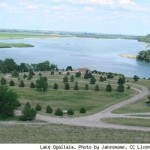
Poland (Polish Geological Institute) – It is well known that the deeper wwiercamy in the Earth’s crust that are more hot rocks. But there are such unusual places on the globe where this rule does not apply. This natural phenomenon, unique in Europe, we are in the Suwalki region, near Udrynia and Szypliszek. In the seventies of last century it was noted that in all the wells in the area, instead of rising temperature with depth – paradoxically decreases!
Dr Jan Szewczyk from the State Geological Institute in 2002 put the hypothesis that the direct cause of this phenomenon is the long-term effects of glaciations, particularly the last – the Vistula glaciation, which started 115 thousand. years ago, and ended with 13 thousand. years ago. According to the investigator that there was no effect on such a scale, however, were it not for the construction of the geological substrate. The relatively shallow beneath the surface of the land there are, in fact called anortozytami magmatic rocks, which are characterized by extremely low content of radioactive isotopes, hence the geothermal heat flux reaching the earth’s surface in this region is extremely low. Dr. Shoemaker did not rule out even the survival of our time until the permafrost, which during the Ice Age was up to his land, and now after a long period of warming, survived the approximately 300 – 400 meters underground.
To further study this phenomenon in the Polish Geological Institute has proposed a special opening performance of research within the anomaly. In July this year, a hole drilled in the framework of a broader research theme “The integrated program of shallow drilling for research to solve important problems of geological Polish”, led by Asst. Dr Hab. Jerzy Nawrocki, Director of the National Geological Institute. Research project, approved by the Ministry of Environment, was funded by the National Fund for Environmental Protection and Water Management. Drilling contractor was Silesian Drilling Company “Dalbis” with Radzionków. Geological supervision exercised, MA Martin Honczaruk from the State Geological Institute.
Drilling, total depth of 450 m, was completed on July 24, 2010 After a break in the work, needed to stabilize the temperature of the partial rocks, July 26, specialists from the company, “Geophysics Krakow – BGW Zielona Gora” conducted geophysical surveys – mainly accurate temperature measurements. The results surpassed expectations of researchers: at a depth of 357 m the temperature fell abruptly to a value of 1.2 o C! Given that the hole was still not thermally stable, it was already assumed that we are dealing with permafrost.
At a depth of 398 meters was set up a filter to allow sampling of the aquifer in the Lower Cretaceous sandstones. During the test pumping was obtained crystal-clear, very low-mineralized water with a temperature at the outlet of just 1.9 °C.
August 3, after further thermal stabilization of the hole, again conducted geophysical surveys. This time, at a depth of 356 meters has been an incredibly low temperature of 0.07 oC. Nobody at the Institute had not expected – certainly, you can now say that the fossil was discovered in the Suwalki region permafrost prior to 13,000 years – the coldest in Europe rocks! What’s more, despite repeated attempts failed to leave the probe below – on the walls of the drill pipe probably arose ice cap – hole just froze …
The research will continue. Borehole was submitted as part of the permanent groundwater monitoring of the National Hydrological Service. Groundwater is treated as a long regime of low temperatures are of particular interest to hydrogeologists because they have many unusual geochemical characteristics, referred to as cryogenic metamorphism.
Discovery paleozmarzliny in the Suwalki region is essential for learning. It is the only place in Central Europe, where you can observe directly the deep permafrost prior to 13,000 years. The study will allow for more accurate modeling of future climate change. Work is also a practical aspect of dragonfly – Palaeoclimatic allow an amendment to the Polish geothermal maps, as well as to measure the number of parameters associated with the movement of groundwater and the tightness of rocks which is of key importance for exploration drilling and underground storage of CO2.
Source: Miroslaw Rutkowski, Spokesman for the Polish Geological Institute.











